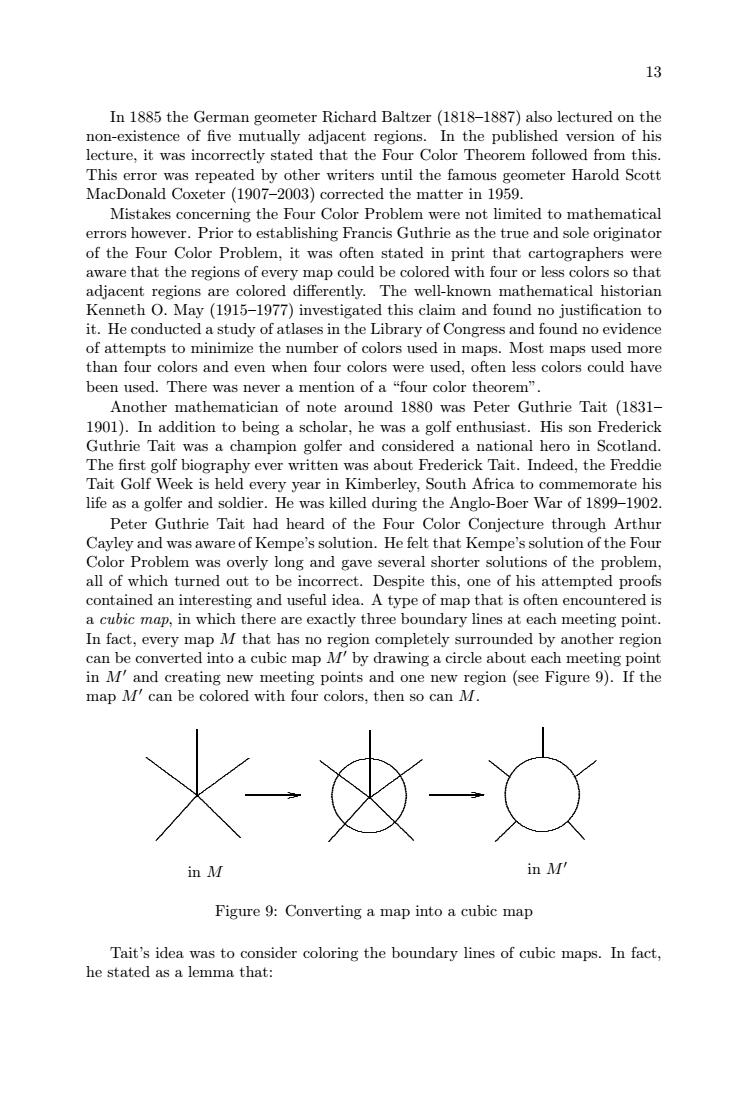正在加载图片...

1n1885theGernman geometer Richard Baltzer (1818-1887) also lectured on thenon-existence of five mutually adjacent regions. In the published version of hislecture, t was incorrectly stated that the Four Color Theorem followed from this.This error was repeated by other writers until the famous geometer Harold ScottMacDonaldCoxeter (1907-2003)correctedthematterin1959Mistakes concerning the Four Color Problem were not limited to mathematicalPrior to establishing Francis Guthrie as the true and sole originatorerrorshoweverof the Four Color Problem,it was often stated in print that cartographers wereawarethattheregions ofeverymap could becolored withfour or lessscolorssothatadjacent recoloreddifferently.Thewell-knoymathematical historianKenneth O.May (1915-1977)investigated this claim and found no justification toit.Hecoucteda study ofatlases in theLibraryof Congressand found noevidenceofattemptstmzethenumber of colors used inmaps.Mostmaps usedmorethanand even when four colors were used, ooftenlesscolorscouldhaveamention ofa"four colortheoremdAnother mathematician of note around 1880 was Peter Guthrie Tait (1831)1901). In addition to being a scholar, he was a golf enthusiast. His son FrederickGuthrie Tait was a champion golfer and considered a national hero in Scotland.The first golf biography ever written was about Frederick Tait. Indeed, the FreddieTait Golf Week is held every year in Kimberley, South Africa to comemorate hislife as a golfer and soldier. He was killed during the Anglo-Boer War of 1899-1902Peter Guthrie Tait had heard of the Four Color Conjecture through ArthulCayley and wasaware of Kempe's solution.HefeltthatKempe's solutionoftheFourColor Probloverly long and gave several shorter solutions of the problemall of which turnedout tobe incorrect.Despite this, one of his attempted proofsg and useful idea. A type of map that is often encountered isnntainedanira cubic map, in which there are exactly three boundary lines at each meeting pointInfact,everymapMthathasnoregioncompletelysuroundedbyanotherregioncan be converted into a cubic map M' by drawing a circle about each meeting pointin M'and creatingmeeting points and one new region (see Figure 9). If themap M'can be colored with four colors,then so can MX--○in MinMFigure 9: Converting a map into a cubic mapTait's idea was to consider coloring the boundary lines of cubic maps. In fact.he stated as a lemma that:13 In 1885 the German geometer Richard Baltzer (1818–1887) also lectured on the non-existence of five mutually adjacent regions. In the published version of his lecture, it was incorrectly stated that the Four Color Theorem followed from this. This error was repeated by other writers until the famous geometer Harold Scott MacDonald Coxeter (1907–2003) corrected the matter in 1959. Mistakes concerning the Four Color Problem were not limited to mathematical errors however. Prior to establishing Francis Guthrie as the true and sole originator of the Four Color Problem, it was often stated in print that cartographers were aware that the regions of every map could be colored with four or less colors so that adjacent regions are colored differently. The well-known mathematical historian Kenneth O. May (1915–1977) investigated this claim and found no justification to it. He conducted a study of atlases in the Library of Congress and found no evidence of attempts to minimize the number of colors used in maps. Most maps used more than four colors and even when four colors were used, often less colors could have been used. There was never a mention of a “four color theorem”. Another mathematician of note around 1880 was Peter Guthrie Tait (1831– 1901). In addition to being a scholar, he was a golf enthusiast. His son Frederick Guthrie Tait was a champion golfer and considered a national hero in Scotland. The first golf biography ever written was about Frederick Tait. Indeed, the Freddie Tait Golf Week is held every year in Kimberley, South Africa to commemorate his life as a golfer and soldier. He was killed during the Anglo-Boer War of 1899–1902. Peter Guthrie Tait had heard of the Four Color Conjecture through Arthur Cayley and was aware of Kempe’s solution. He felt that Kempe’s solution of the Four Color Problem was overly long and gave several shorter solutions of the problem, all of which turned out to be incorrect. Despite this, one of his attempted proofs contained an interesting and useful idea. A type of map that is often encountered is a cubic map, in which there are exactly three boundary lines at each meeting point. In fact, every map M that has no region completely surrounded by another region can be converted into a cubic map M′ by drawing a circle about each meeting point in M′ and creating new meeting points and one new region (see Figure 9). If the map M′ can be colored with four colors, then so can M. . .. ... .... ...... ........ ............... .............. ...... ........ ..... .... ... .... ................................................................................. . . . .. ... .... ...... ........ ...................... .... ............... ...... .... ... .. .. ................................................................................. . ...................................... .. . . . . . . . . . . . . . . . . . . . . . ........... .. . .. .......... ......... . . . . . . . . . . . . . . . . . . . . . . ....................................... ......................................................................................................................................... ................................................................... ............ .. .. .. .. .. .. .. .. .. ......... . . . .. ... .......... ........ .......................... ............................. ...................................................................... in M in M′ Figure 9: Converting a map into a cubic map Tait’s idea was to consider coloring the boundary lines of cubic maps. In fact, he stated as a lemma that: